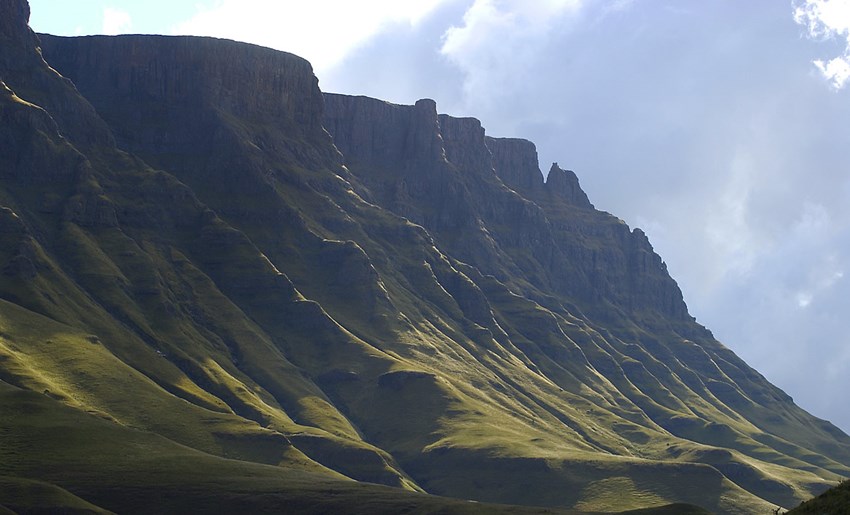Blog


16/09/2015

The spectacular and ancient uKhahlamba-Drakensberg mountain range is Southern Africa's highest range, peaking at 3 475 metres and stretching for more than 1 000km from northeast to southwest across the landscape.
In Zulu the range is known as uKhahlamba, meaning 'barrier of spears', which does justice to its dramatic basalt buttresses. Early settlers called it the Drakensberge, because they believed it resembled a dragon's back.
One of the country's premier attractions, the Drakensberg range offers panoramic views from its higher reaches, attracting hikers, mountaineers, abseilers, parasailers and skieers to its game reserves and parks.
The mountains, with numerous valleys and rivers, is an outdoor playground where South Africans enjoy leisure time pursuing activities including trout fishing, kayaking, tubing, swimming, 4x4 trails, quad biking, horse riding, photography, bird watching, rambling, rock climbing and hot air balloon rides over hidden valleys.
The Drakensberg is historically divided into the southern, central and northern 'Berg', with major landmarks such as Cathedral Peak, Cathkin Peak, Mont-aux-Sources, Monk's Cowl, the Amphitheatre, Sani Pass and Champagne valley making it easier to negotiate.
Geologically the mountain comprises a sandstone layer covered by a 1 400-metre-thick basalt layer. This make-up has created hundreds of caves and overhangs where the ancient San people, who roamed freely in the region some 4 000 years ago, have left their mark in the form of more than 30 000 paintings in an estimated 600 caves.
The mountains are also home to a large number of threatened and endemic plants such as the protea, cycad, cabbage tree, tree fern, and giant yellowwood, along with flowers including lilies, lion’s tail, helicrysum, erica, agapanthus, watsonia, and the red hot poker.
More than 300 bird species recorded here range from the tiny greater double-collared sunbird to large raptors like the eagle, buzzard and vulture.
The uKhahlamba-Drakensberg Park, administered by Ezemvelo KZN Wildlife, is approximately two hours' drive from Durban and the Indian Ocean. It lies within the Drakensberg mountain range in KwaZulu-Natal province and is a world-class ecotourism centre. The park was declared a World Heritage Site by Unesco in 2000 and spans 150km over 243 000 hectares of land.
You'll marvel at the 'Berg's' towering cliffs, unspoilt forests, soaring peaks and rich animal life, including eagle and eland. Swim in crystal clear rivers, explore the area by mountain bike or simply chill and enjoy the glorious vistas. Accommodation is plentiful and ranges from basic to luxurious.
TRAVEL TIPS & PLANNING INFO
WHO TO CONTACT
Drakensberg Tourism Association
Tel: +27 (36) 448 1557
Email: info@drakensberg.org.za
BEST TIME TO VISIT
Spring (September, October and November) as well as autumn (March, April and May) are very good months with stable weather. Summer is characterised by dramatic thundershowers, and in winter it can get very cold with snow.
AROUND THE AREA
Visit the Drakensberg Boys' Choir School, adjacent to the Dragon Peaks holiday resort.
TOURS TO DO
Horse riding, fishing, golf and bowls are popular pastimes in the Drakensberg Mountains, as are game and bird-viewing tours, 4x4 routes, mountain biking and helicopter flips.
GET AROUND
It's best to drive yourself, or explore the area on foot. In some areas, you can travel by mountain bike or on horseback.
LENGTH OF STAY
Spend at least two nights here – more if you enjoy hiking.
WHAT TO PACK
In summer, take rain gear. In winter, pack plenty of warm clothes.
WHERE TO STAY
Accommodation in the Drakensberg mountains is plentiful and includes B&Bs, hotels, guest houses, camping and caravanning, self-catering options, bush camps, lodges and resorts.
From: South Africa Tourism
Image: Wikipedia

11/07/2019

21/08/2018

29/09/2017